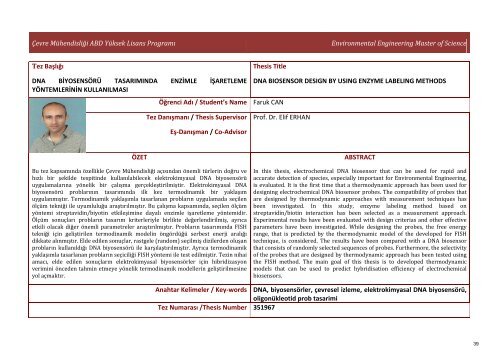GTÜ FBE Lisansüstü Programlar ve Tez Özetleri
You also want an ePaper? Increase the reach of your titles
YUMPU automatically turns print PDFs into web optimized ePapers that Google loves.
Çevre Mühendisliği ABD Yüksek Lisans Programı<br />
Environmental Engineering Master of Science<br />
<strong>Tez</strong> Başlığı<br />
Thesis Title<br />
DNA BİYOSENSÖRÜ TASARIMINDA ENZİMLE İŞARETLEME<br />
YÖNTEMLERİNİN KULLANILMASI<br />
Öğrenci Adı / Student’s Name Faruk CAN<br />
DNA BIOSENSOR DESIGN BY USING ENZYME LABELING METHODS<br />
<strong>Tez</strong> Danışmanı / Thesis Supervisor<br />
Prof. Dr. Elif ERHAN<br />
Eş-Danışman / Co-Advisor<br />
ÖZET<br />
Bu tez kapsamında özellikle Çevre Mühendisliği açısından önemli türlerin doğru <strong>ve</strong><br />
hızlı bir şekilde tespitinde kullanılabilecek elektrokimyasal DNA biyosensörü<br />
uygulamalarına yönelik bir çalışma gerçekleştirilmiştir. Elektrokimyasal DNA<br />
biyosensörü problarının tasarımında ilk kez termodinamik bir yaklaşım<br />
uygulanmıştır. Termodinamik yaklaşımla tasarlanan probların uygulamada seçilen<br />
ölçüm tekniği ile uyumluluğu araştırılmıştır. Bu çalışma kapsamında, seçilen ölçüm<br />
yöntemi streptavidin/biyotin etkileşimine dayalı enzimle işaretleme yöntemidir.<br />
Ölçüm sonuçları probların tasarım kriterleriyle birlikte değerlendirilmiş, ayrıca<br />
etkili olacak diğer önemli parametreler araştırılmıştır. Probların tasarımında FISH<br />
tekniği için geliştirilen termodinamik modelin öngördüğü serbest enerji aralığı<br />
dikkate alınmıştır. Elde edilen sonuçlar, rastgele (random) seçilmiş dizilerden oluşan<br />
probların kullanıldığı DNA biyosensörü ile karşılaştırılmıştır. Ayrıca termodinamik<br />
yaklaşımla tasarlanan probların seçiciliği FISH yöntemi ile test edilmiştir. <strong>Tez</strong>in nihai<br />
amacı, elde edilen sonuçların elektrokimyasal biyosensörler için hibridizasyon<br />
<strong>ve</strong>rimini önceden tahmin etmeye yönelik termodinamik modellerin geliştirilmesine<br />
yol açmaktır.<br />
ABSTRACT<br />
In this thesis, electrochemical DNA biosensor that can be used for rapid and<br />
accurate detection of species, especially important for Environmental Engineering,<br />
is evaluated. It is the first time that a thermodynamic approach has been used for<br />
designing electrochemical DNA biosensor probes. The compatibility of probes that<br />
are designed by thermodynamic approaches with measurement techniques has<br />
been in<strong>ve</strong>stigated. In this study, enzyme labeling method based on<br />
streptavidin/biotin interaction has been selected as a measurement approach.<br />
Experimental results ha<strong>ve</strong> been evaluated with design criterias and other effecti<strong>ve</strong><br />
parameters ha<strong>ve</strong> been in<strong>ve</strong>stigated. While designing the probes, the free energy<br />
range, that is predicted by the thermodynamic model of the de<strong>ve</strong>loped for FISH<br />
technique, is considered. The results ha<strong>ve</strong> been compared with a DNA biosensor<br />
that consists of randomly selected sequences of probes. Furthermore, the selectivity<br />
of the probes that are designed by thermodynamic approach has been tested using<br />
the FISH method. The main goal of this thesis is to de<strong>ve</strong>loped thermodynamic<br />
models that can be used to predict hybridisation efficiency of electrochemical<br />
biosensors.<br />
Anahtar Kelimeler / Key-words DNA, biyosensörler, çevresel izleme, elektrokimyasal DNA biyosensörü,<br />
oligonükleotid prob tasarimi<br />
<strong>Tez</strong> Numarası /Thesis Number 351967<br />
39




